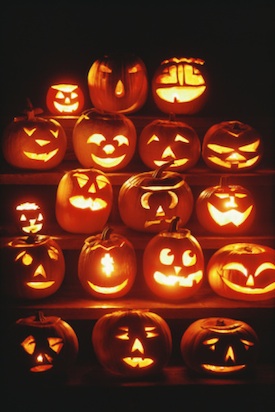Parenting Archive
How To Have a Safe (and Happy) Halloween!
By Chris Woolston (HealthDay)
Whoever came up with the idea of having kids roam neighborhoods at night to collect candy from strangers definitely wasn't a child-safety expert. Halloween can be dangerous -- but not necessarily for the reasons people think. Many parents worry about poison or razor blades tucked away into candy. Studies have failed to establish this as a hazard, however, and the threat has been dubbed "mythical" by a Mt. Holyoke College criminologist.
definitely wasn't a child-safety expert. Halloween can be dangerous -- but not necessarily for the reasons people think. Many parents worry about poison or razor blades tucked away into candy. Studies have failed to establish this as a hazard, however, and the threat has been dubbed "mythical" by a Mt. Holyoke College criminologist.
Concerned parents may be overlooking the spooky night's real dangers, however: Traffic, fire hazards and falls. The American Medical Association and the U.S. Centers for Disease and Prevention offers these tips to keep your little ghosts and goblins safe:
• Join in the fun: Young children shouldn't trick-or-treat without an adult along.
• Children should trick-or-treat only in well-lighted neighborhoods with sidewalks.
• Be sure your children can remember to cross streets at corners and to look both ways before they go.
• Make sure trick-or-treaters carry a flashlight after dark.
• Attach reflective tape to costumes and candy bags.
• Don't walk near candles.
• Bracelets and necklaces that glow in the dark can serve as alternatives to reflective tape and also make your child more visible to a passing motorist.
• Unless you're planning to escort your child all night, help him put on some scary face paint instead of a mask. A kid in a mask can't see well enough to be aware of his surroundings.
Clear the hazards
Of course, cars aren't the only Halloween hazard. The American Academy of Pediatrics offers these additional tips to keep the holiday safe:
• Make sure you're child's costume is flame-retardant and fits properly. Extra-big shoes, long pants, or a billowing skirt could cause a nasty fall.
• Don't let small children carve pumpkins. They'll be perfectly happy drawing the face with markers and watching you do the cutting.
• Even though Halloween poisonings are practically unheard-of, it still makes sense to inspect your child's candy before he eats it. If the wrapper is torn or missing, throw the candy out.
• Before the big night, make sure your porch light works.
• Keep your lawn, stairs, porch, and sidewalk clear of anything (including wet leaves or snow) that could cause a fall.
References:
American Academy of Pediatrics. Halloween Safety Tips. October 2010. http://www.aap.org/advocacy/releases/octhalloween.htm
Halloween Health and Safety. U.S. Center for Disease Control and Prevention. Dec. 16, 2009. ; Statistical Assessment Service, STATS Spotlight, Holiday Mischief. ; Centers for Disease Control and Prevention, Childhood Pedestrian Deaths During Halloween -- United States, 1975-1996, MMWR, October 24, 1997, 46(42):987-990.
Copyright ©2011 LimeHealth. All Rights Reserved.
Past Articles:
How To Have a Safe (and Happy) Halloween!Delaying Alzheimer's with a Spray of Insulin up the Nose



